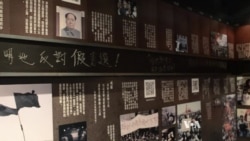HONG KONG —
A permanent museum to remember the Tiananmen crackdown of 1989 has officially opened in Hong Kong. Organizers say that 25 years after the events, Chinese people need to know more about what happened, and call on Beijing to face its troubled history.
The exhibition is the world's first museum dedicated to the brutal crackdown ordered by the Chinese leadership 25 years ago.
While references to the crackdown are banned on the mainland, activists and politicians in Hong Kong have long called on Beijing to offer a full account of what happened on June 4th, 1989.
Lee Cheuk-yan, chairman of the Hong Kong Alliance in Support of Patriotic Democratic Movements of China, who is one of the organizers, says the media blackout has left younger generations in the dark.
“They are very confused about what happened in Tianamen. They should come here to learn more about June Fourth. We also hope they can carry that knowledge and the spirit of the students movement back to China and strive for for democracy,” he said.
The museum takes up less than 75 square meters on the fifth floor of an office building in the Tsim Sha Tsui tourist district.
It is organized as a maze with pictures and written accounts of the events leading up to the crackdown, when the government ordered the People's Liberation Army to shoot at protesters.
In 1989, Chen Qinghua was a representative sent by the Hong Kong Student Association to support the student movement, which had been demonstrating for months against corruption and calling for political reform.
He says that in the late evening of June third he was at a medical station near Tiananmen Square and what he saw filled him with disbelieve and anger.
“Starting from 10:30, 11 o’clock, people were brought in with gun wounds. Some of them were dead on arrival. It was so sudden that, you are never prepared for that,” said Chen.
An official death toll has never been made public, and estimates range from hundreds to thousands of dead.
The government in China says the protests were counter-revolutionary and insists that China has moved on from that political turmoil.
The last 30 years of development, Beijing says, show that the country has reached a “clear conclusion” on those events.
Liu Ruishao, an Hong Kong journalist, was in Beijing during the crackdown and says that economic development alone will not make China strong.
“June Fourth is a wound for all the Chinese people. If we do not absorb the lessons from what happened, the efforts for a prosperous and enlightened nation will all be useless,” said Liu.
The museum, which opened Saturday, ran into some opposition.
The building's owners committee tried to block the opening with a vote earlier this month, an effort that organizers say was due to pressure from mainland authorities.
On Saturday, pro-Beijing protesters stood outside the museum's building holding banners suggesting violence was started by the student movement.
The exhibition is the world's first museum dedicated to the brutal crackdown ordered by the Chinese leadership 25 years ago.
While references to the crackdown are banned on the mainland, activists and politicians in Hong Kong have long called on Beijing to offer a full account of what happened on June 4th, 1989.
Lee Cheuk-yan, chairman of the Hong Kong Alliance in Support of Patriotic Democratic Movements of China, who is one of the organizers, says the media blackout has left younger generations in the dark.
“They are very confused about what happened in Tianamen. They should come here to learn more about June Fourth. We also hope they can carry that knowledge and the spirit of the students movement back to China and strive for for democracy,” he said.
The museum takes up less than 75 square meters on the fifth floor of an office building in the Tsim Sha Tsui tourist district.
It is organized as a maze with pictures and written accounts of the events leading up to the crackdown, when the government ordered the People's Liberation Army to shoot at protesters.
In 1989, Chen Qinghua was a representative sent by the Hong Kong Student Association to support the student movement, which had been demonstrating for months against corruption and calling for political reform.
He says that in the late evening of June third he was at a medical station near Tiananmen Square and what he saw filled him with disbelieve and anger.
“Starting from 10:30, 11 o’clock, people were brought in with gun wounds. Some of them were dead on arrival. It was so sudden that, you are never prepared for that,” said Chen.
An official death toll has never been made public, and estimates range from hundreds to thousands of dead.
The government in China says the protests were counter-revolutionary and insists that China has moved on from that political turmoil.
The last 30 years of development, Beijing says, show that the country has reached a “clear conclusion” on those events.
Liu Ruishao, an Hong Kong journalist, was in Beijing during the crackdown and says that economic development alone will not make China strong.
“June Fourth is a wound for all the Chinese people. If we do not absorb the lessons from what happened, the efforts for a prosperous and enlightened nation will all be useless,” said Liu.
The museum, which opened Saturday, ran into some opposition.
The building's owners committee tried to block the opening with a vote earlier this month, an effort that organizers say was due to pressure from mainland authorities.
On Saturday, pro-Beijing protesters stood outside the museum's building holding banners suggesting violence was started by the student movement.








